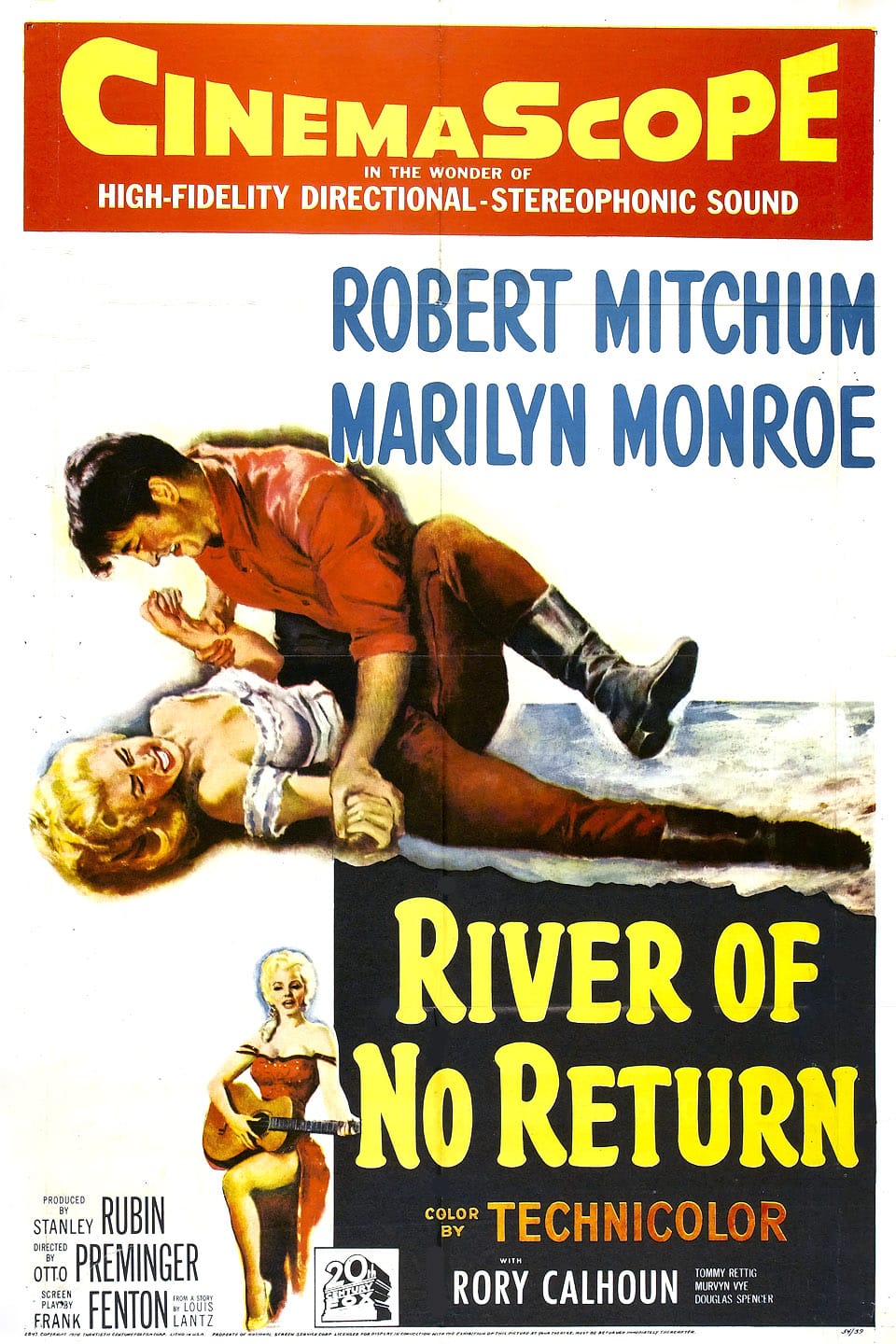
- Starring
- Robert Mitchum, Marilyn Monroe, Rory Calhoun
- Writer
- Frank Fenton
- Director
- Otto Preminger
- Rating
- PG (Canada)
- Running Time
- 91 minutes
Overall Score
Rating Summary
Screenwriter Frank Fenton claims that he drew inspiration from Vittorio De Sica’s Bicycle Thieves when putting this formulaic Western together. This declaration of intent begins to seem circumspect when you actually sit down and watch the film, which captures none of the grit or aching sincerity that allowed that Italian neorealist classic to transcend the limitations of its simplistic premise. River of No Return is not rooted in a specific sociopolitical context and offers up a surface level exploration of its most significant themes. The limitations of its script ensure that the film plays as a celebration of the serene beauty of the natural world. Vistas of vast landscapes, unpopulated by human beings, end up overshadowing the un-involving human drama at the story’s center.
Fenton chose to shift the narrative’s location to the Northwestern United States in 1875 and opens the film with a sequence in which Matt Calder (Mitchum), a recently discharged prisoner, journeys through a boomtown settlement. He is searching for his estranged son, Mark (Tommy Rettig), who last saw his father when he was just a few months old. Calder hopes to step in and re-establish a bond with his son while attempting to rebuild his life as an ordinary citizen. His plans for the future are thrown into disarray when ne’er-do-well Harry Weston (Calhoun) steals all of his worldly possessions. Weston intends to travel to Council City in order to file a claim on a gold mine. His supportive fiancée Kay Weston (Monroe) wishes to accompany him on this journey but ends up staying in the wilderness with the victims of her boyfriend’s criminal actions. Weston becomes an ally to Calder and his son after they survive an attack carried out by Native Americans. Having exhausted all other possibilities, they set off for Council City on a flimsy raft and find themselves evolving into a makeshift family unit.
River of No Return displays real promise during its opening scene, which provides viewers with a surprisingly atmospheric glimpse at life on the lawless frontier. Director Otto Preminger envisions the haphazardly constructed settlement as a modernized Sodom and Gomorrah, in which immoral gamblers and lusty showgirls indulge their sinful urges. His portrait of this setting is flush with the sort of precision and detail that the rest of the film noticeably lacks. There’s an unexpected warmth and vigor to Preminger’s tentative efforts to ape John Ford and he even takes the opportunity to insert an exceptionally showy long-take into the proceedings. For about ten minutes, the film manages to sucker viewers into believing that the film is up there with Preminger’s most thrilling genre-based experiments.
Ultimately, everything goes downhill after Calder’s tussle with Weston, as it quickly devolves into mushy melodrama. Mitchum and Monroe make valiant attempts to breathe some life into the hackneyed clichés that they’re forced to sell to the audience, but neither of them seemed passionately invested in this project. It doesn’t help that Preminger appears to be actively disengaged from the characters. His emotionally removed approach might have yielded something fascinating if the script were less dialogue-heavy but Fenton chose to embed multiple different character arcs into the narrative. As it is, the film screeches to a halt whenever the main characters step off the raft and start waxing lyrical about their tragic pasts. All of the predictable emotional beats that Fenton aims to hit, never fully register. The film’s final scene elicits a shrug because it never develops an emotional attachment to any of these characters.
That being said, there are still moments at which Joseph LaShelle delivers a particularly dazzling shot of tree leaves blowing in the wind or cliffsides overlooking crystal clear waters. He uses cutting edge technology in a confident manner and definitively proves that CinemaScope could do more than just fit three different actors into a single frame. However, one can still understand why Preminger looked upon this film as a noble failure. He behaved like a tyrant on set and failed to work around the weaknesses in the script that he was saddled with. It’s fair to say that the technical proficiency on display remains impressive, but River of No Return isn’t as entertaining as a Mitchum/Monroe two-hander should have been.
still courtesy of 20th Century Studios
If you liked this, please read our other reviews here and don’t forget to follow us on Twitter or Instagram or like us on Facebook.

I am passionate about screwball comedies from the 1930s and certain actresses from the Golden Age of Hollywood. I’ll aim to review new Netflix releases and write features, so expect a lot of romantic comedies and cult favourites.
Discover more from
Subscribe to get the latest posts sent to your email.
